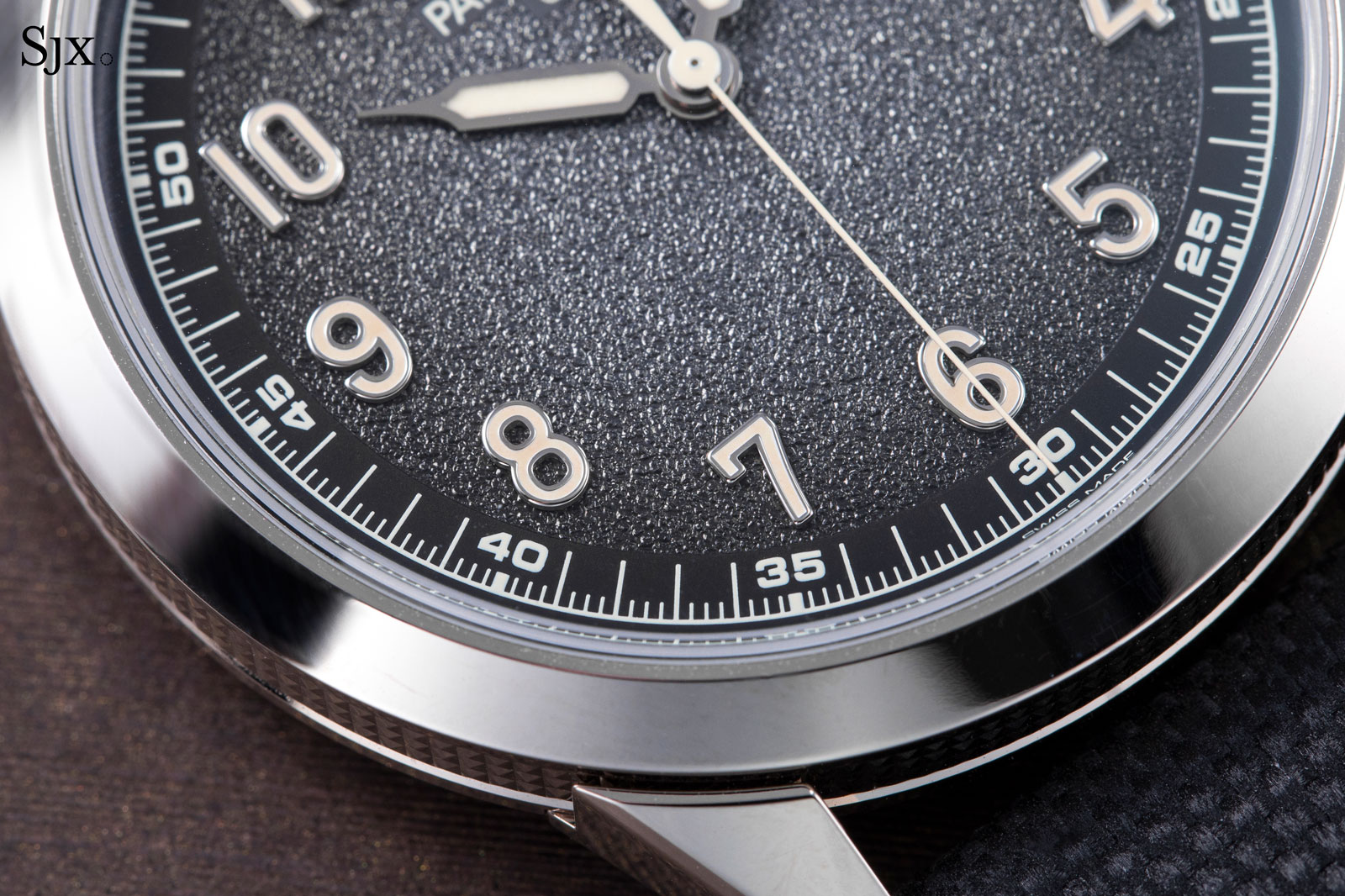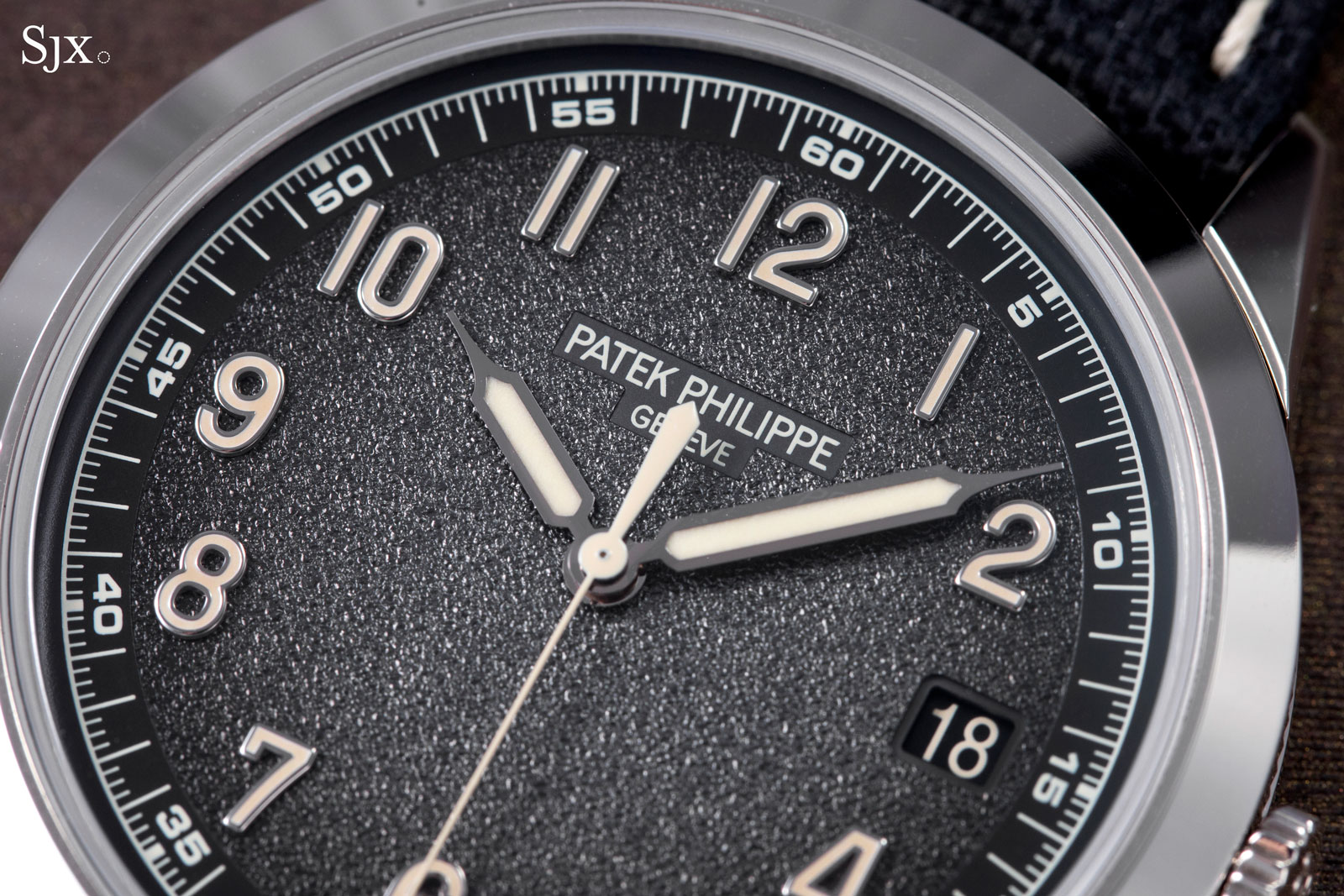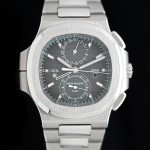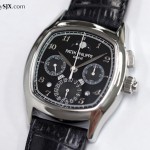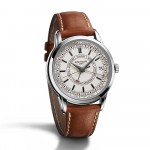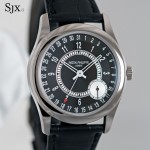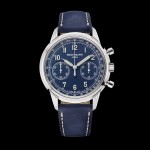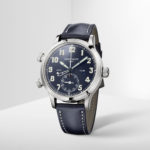Up Close: Patek Philippe Calatrava Ref. 5226G
Contemporary and beautifully detailed.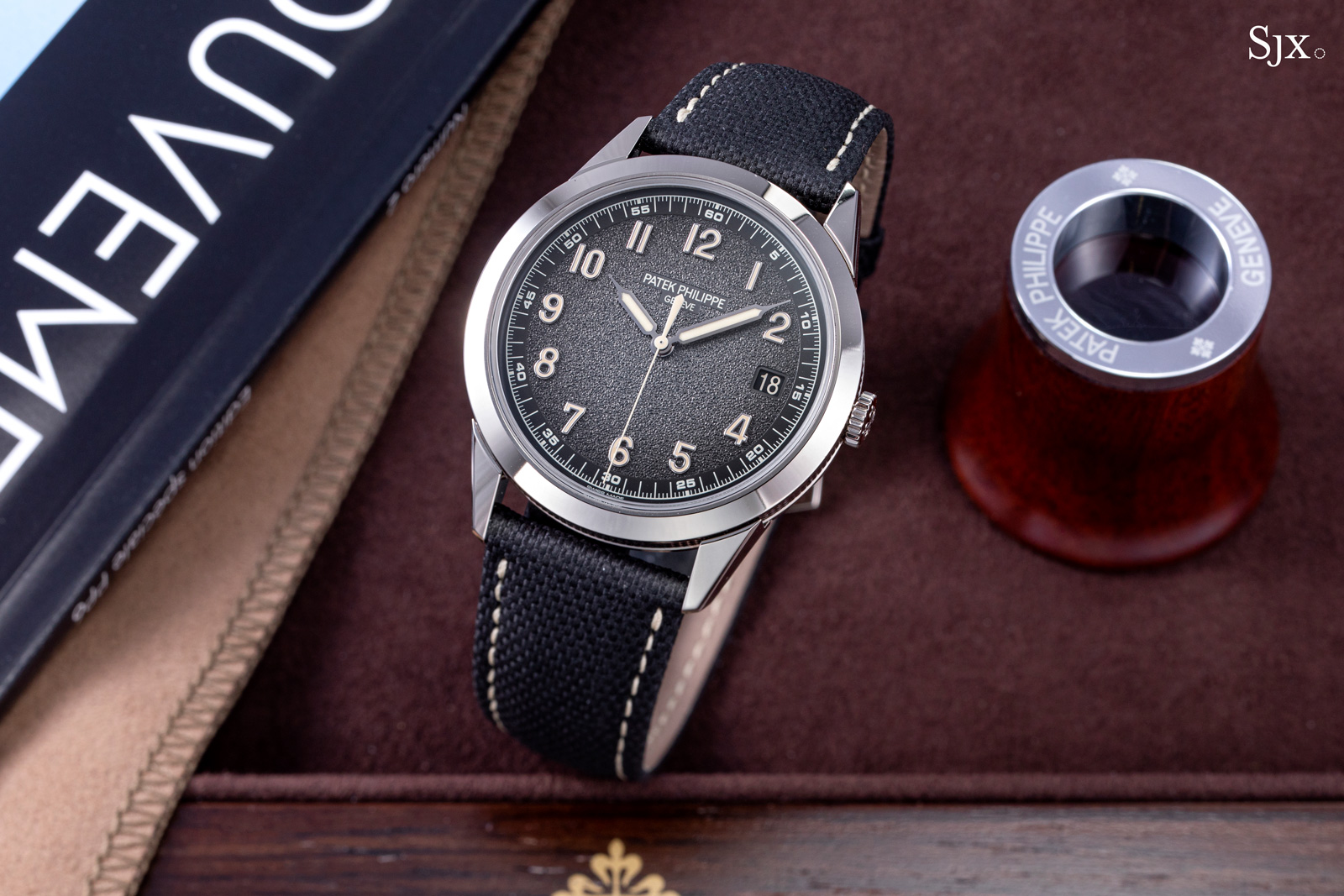
Continuing the brand’s well-known intentions to liven up the Calatrava, Patek Philippe unveiled a brand-new take on its quintessential dress watch at Watches & Wonders earlier this year, the Calatrava ref. 5226G-01.
The ref. 5226G indicates where the Calatrava line is going – more contemporary design, albeit still informed by vintage models hence the faux vintage lume, which is enhanced with sharper and higher quality detailing. Despite an entry-level watch of sorts (despite a substantial price tag), the ref. 5226G is nonetheless elaborately executed. The hobnail decoration found on last year’s ref. 6119 “Clous de Paris”, for instance, has been repurposed and applied to the case band.
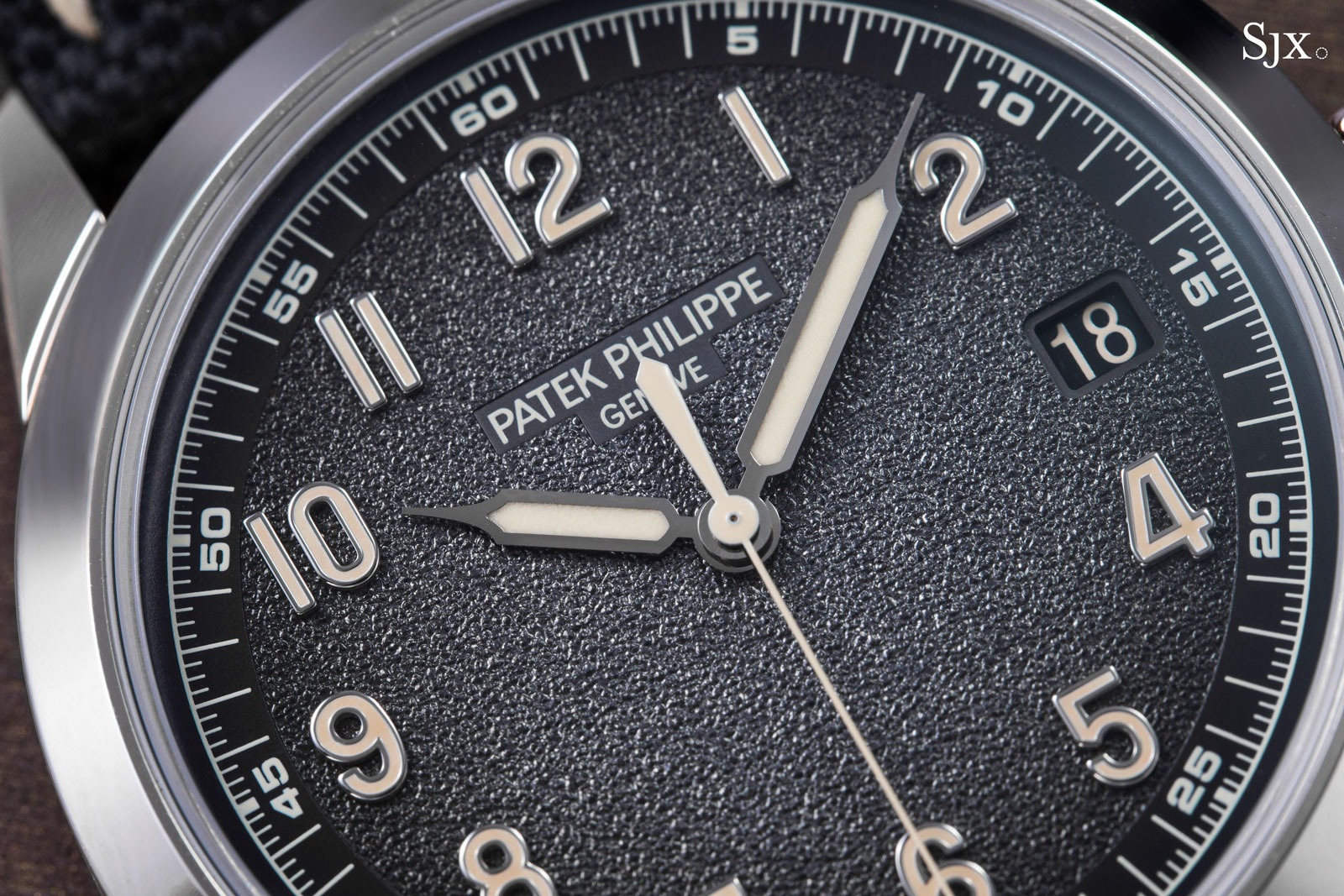
The dial gets a pronounced grained finish
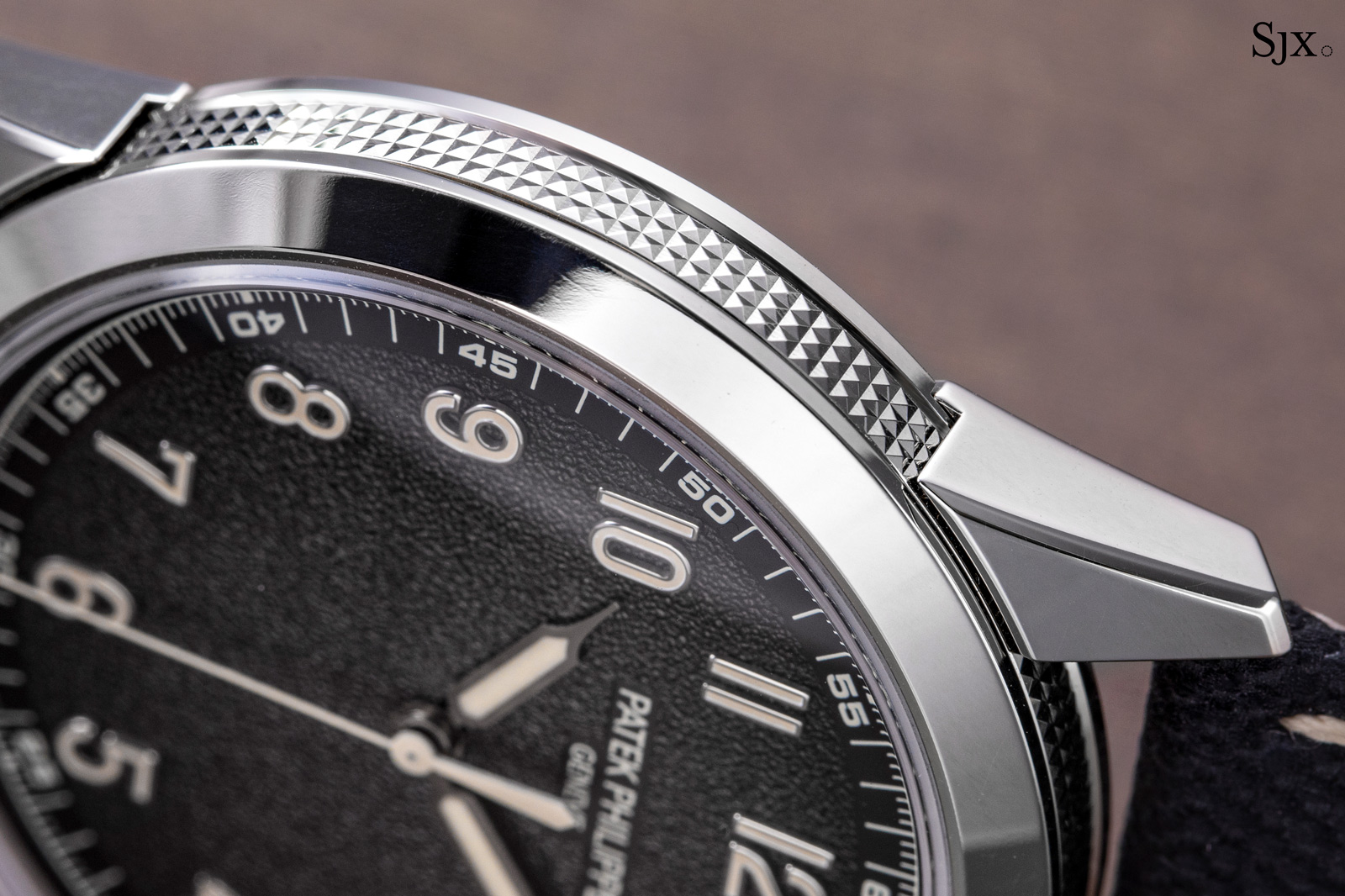
And the case a clous de Paris decoration
Initial thoughts
I first encountered the ref. 5226G in larger-than-life format when it appeared on the floor-to-ceiling display on the side of Patek Philippe at Watches & Wonders.
The scale of the projection meant the patterned dial and hobnail case were instantly obvious. Though unexpected elements in an entry-level Patek Philippe, they work well together, both on screen and in real life.

Patek Philippe at Watches & Wonders 2022 with its oversized digital display. Image – Watches & Wonders
When I tried on the watch during the fair, my positive impression was reinforced. Even though the ref. 5226G is a combination of elements not usually put together, it is compelling and appealing in the metal. Although the dial brings to mind a vintage military watch, the polished case with its hobnail band and the applied numerals on the dial give it a refined feel.
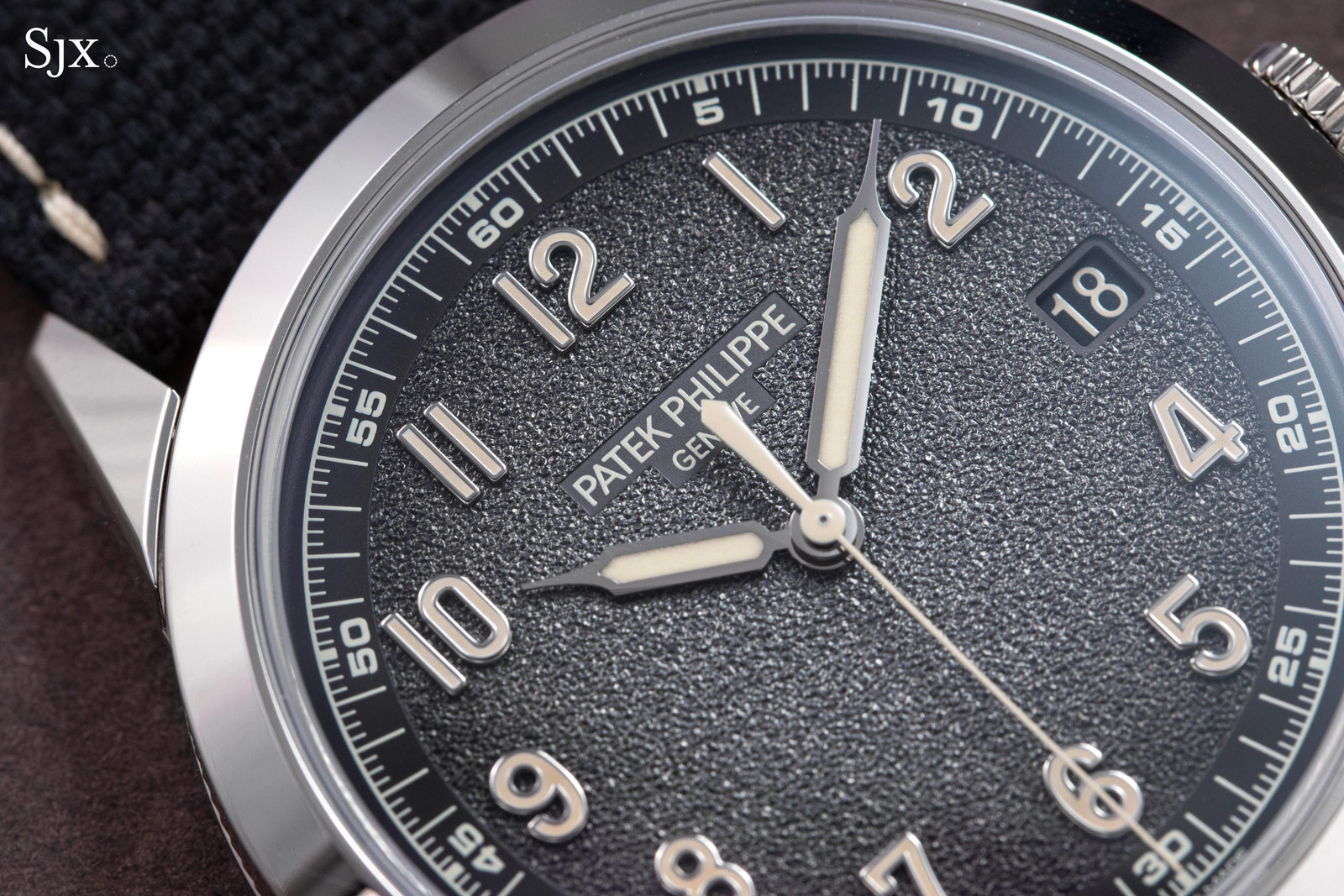
Granted, the individual elements of the ref. 5226G are ordinary and well used, which is perhaps why the model was criticised for being seemingly derivative. But like a few other Calatrava designs, the ref. 5226G combines familiar elements in a manner that’s unusual – with a high level quality in execution – resulting in a tactile feel that is best described as appealingly high-end. In other words, the ref. 5226G is a highly refined watch for the gentleman explorer.
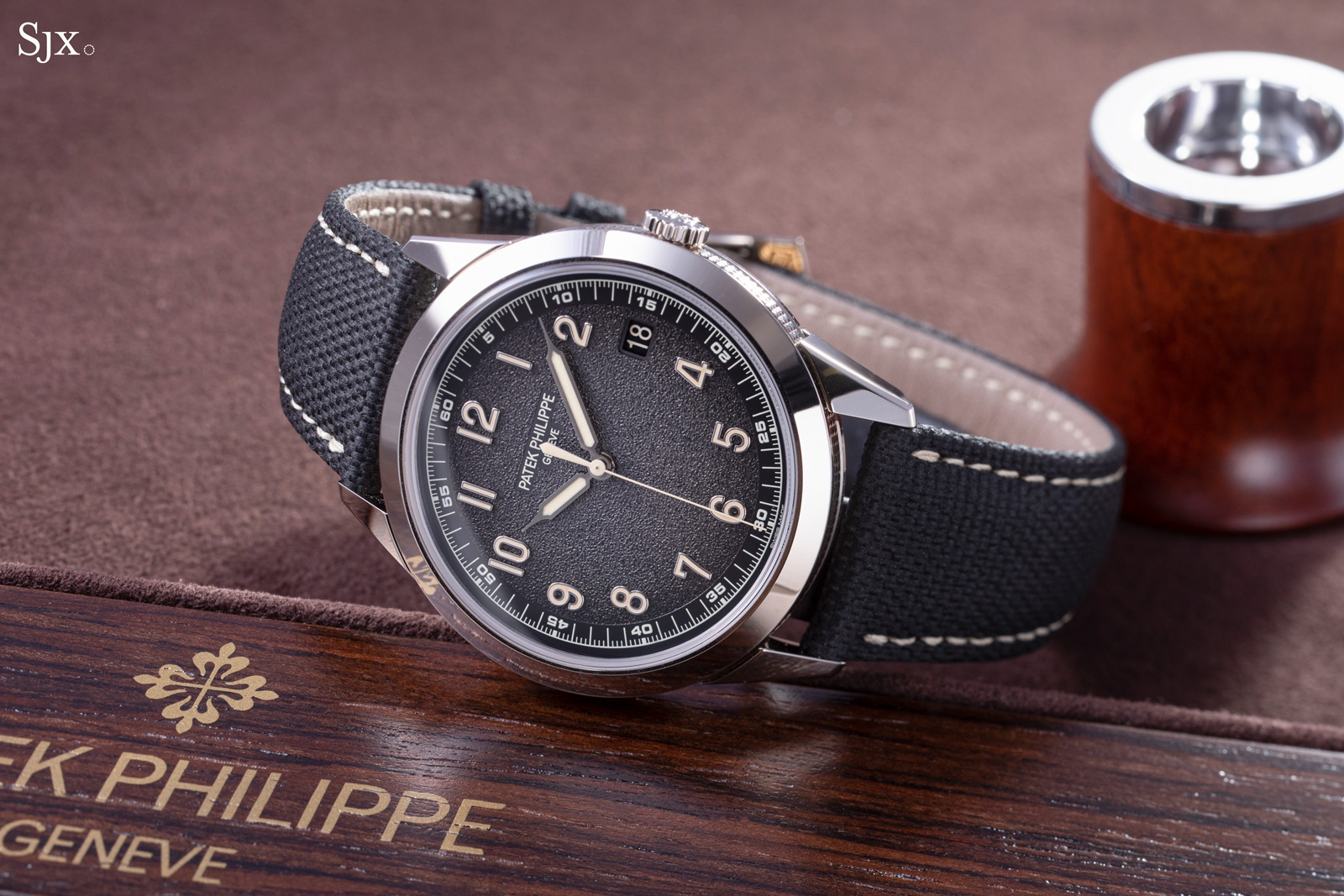
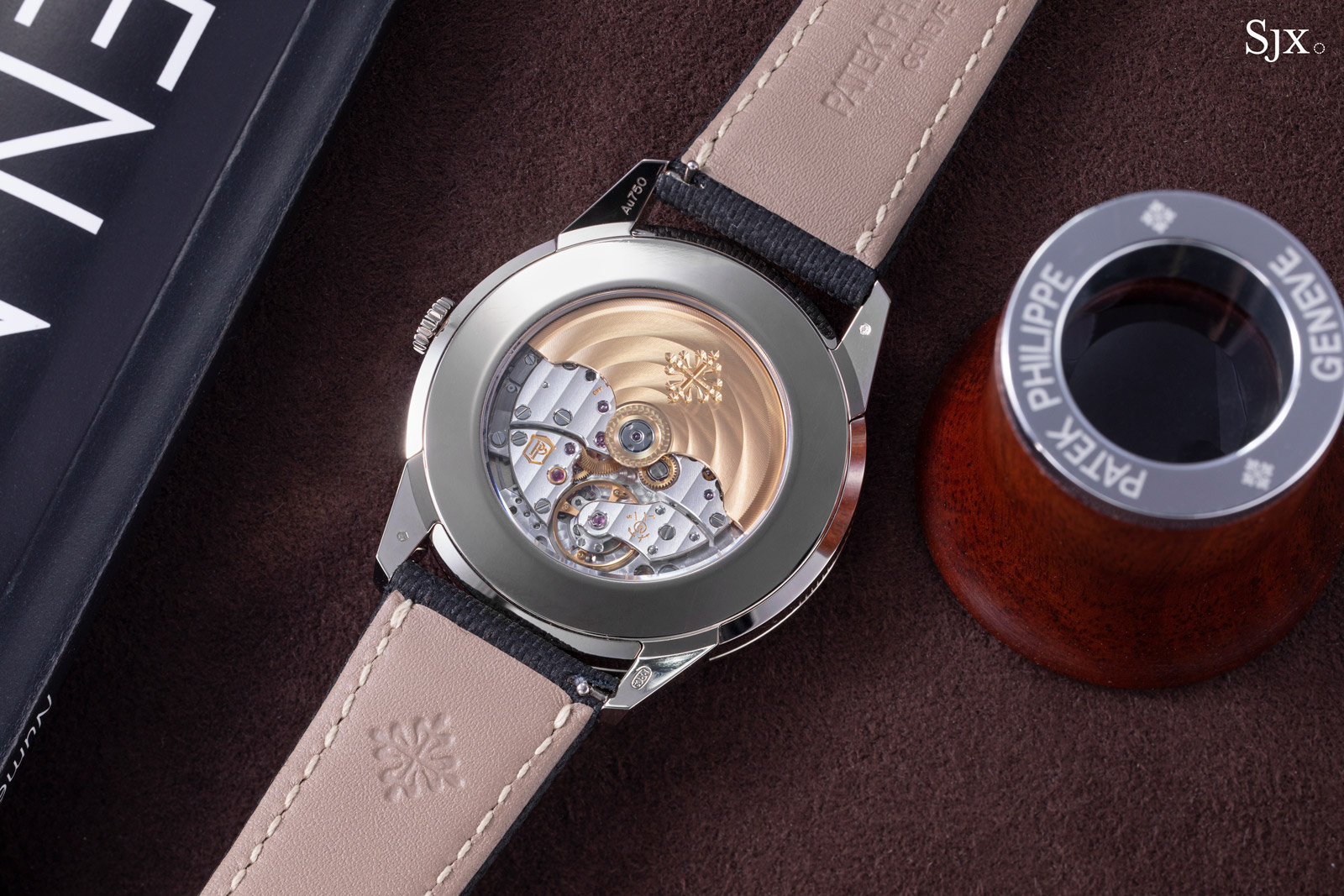
And seen from a broader perspective, the ref. 5226G is perhaps a landmark in the evolution of Calatrava. I think it’s more attractive than the limited-edition ref. 6007A, which was one of the first modernised designs of the current generation. The basketweave pattern of the ref. 6007A seemed a bit too classical for a “modern” Calatrava. On the other hand, the ref. 5226G has a design that is coherently contemporary across its various elements.
As is often the case with Patek Philippe, the only drawback of the ref. 5226G is the price. At US$39,030, the ref. 5226G is amongst the most expensive time-and-date watches in its segment, priced higher than comparable watches from Lange or Vacheron Constantin.
But the ref. 5226G is a Patek Philippe – as it is with Ferrari the name is worth a lot – and it is a well-balanced package across all dimensions, design, size, finish, and feel. Admittedly, the ref. 5226G is fancier in terms of execution compared to most other Calatrava models. Also important is the fact that the ref. 5226G has an unusual aesthetic that is classical yet recognisable, an achievement for a watch in this segment.
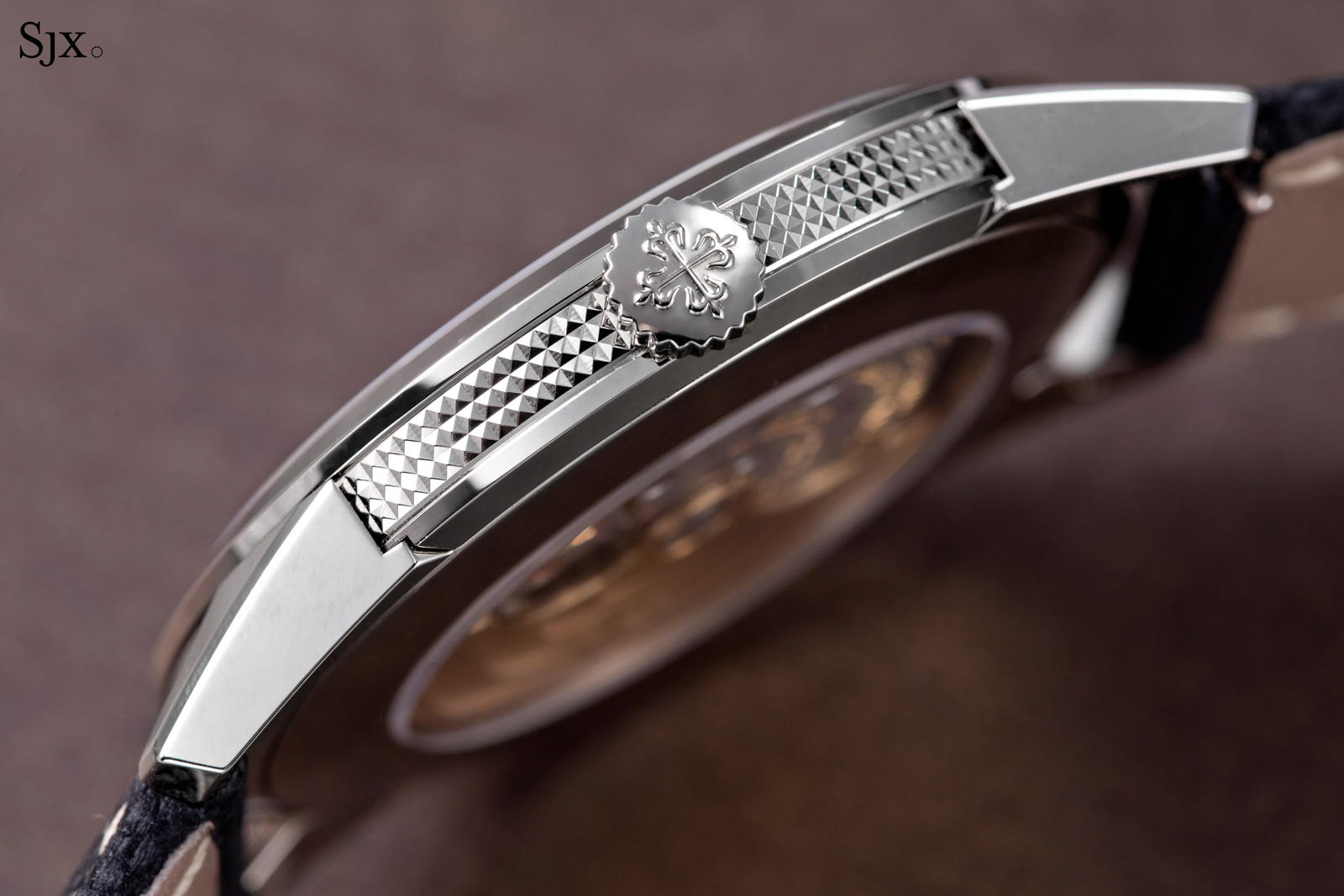
Of course the ref. 5226G wasn’t the only watch in this style launched during the fair. Its more complicated sibling, the ref. 5236G, sports both the annual calendar and second time zone complications.
Between the two, I prefer the time-and-date ref. 5226G because its thinner, simpler form feels more elegant and concise. Though I appreciate the technical innovations in its bigger brother, the ref. 5236G feels bulky due to its thickness. At the same time, the simplicity of the ref. 5226G allows the details on its case and dial to be more apparent.
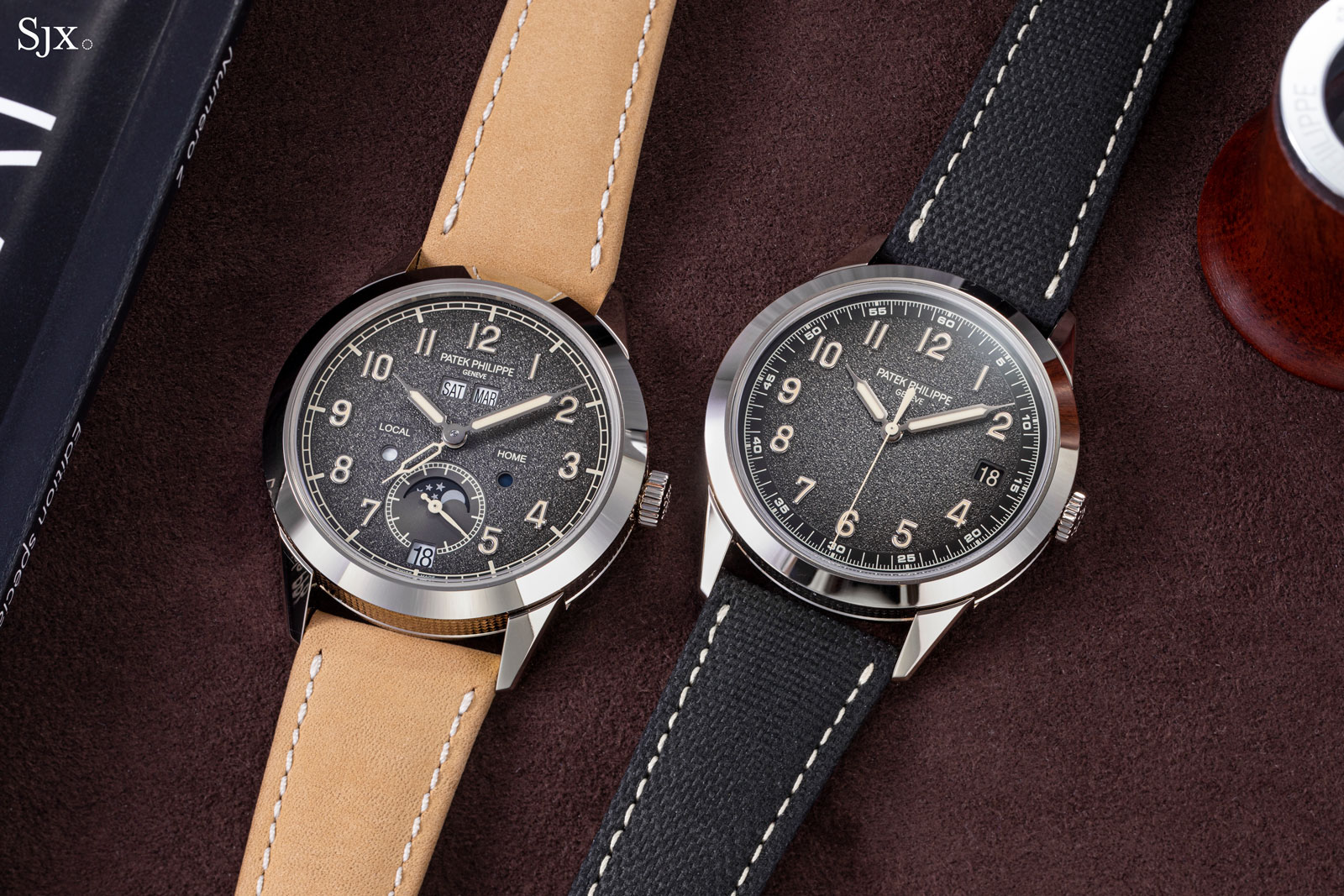
The Calatrava Annual Calendar Travel Time ref. 5236G (left) and ref. 5226G. Each is delivered with the two straps shown above.
Hobnailed flanks
Though both the dial and case of the ref. 5226G are novel for a Calatrava, the case is certainly the highlight. The hobnail pattern on the case middle is a pleasing detail that gives the watch a distinctive feature but one that is subtle. The hobnail bezel of the ref. 6119 has its fans but some will no doubt find it too much. On the ref. 5226G, the three rows of hobnails are only visible in profile.
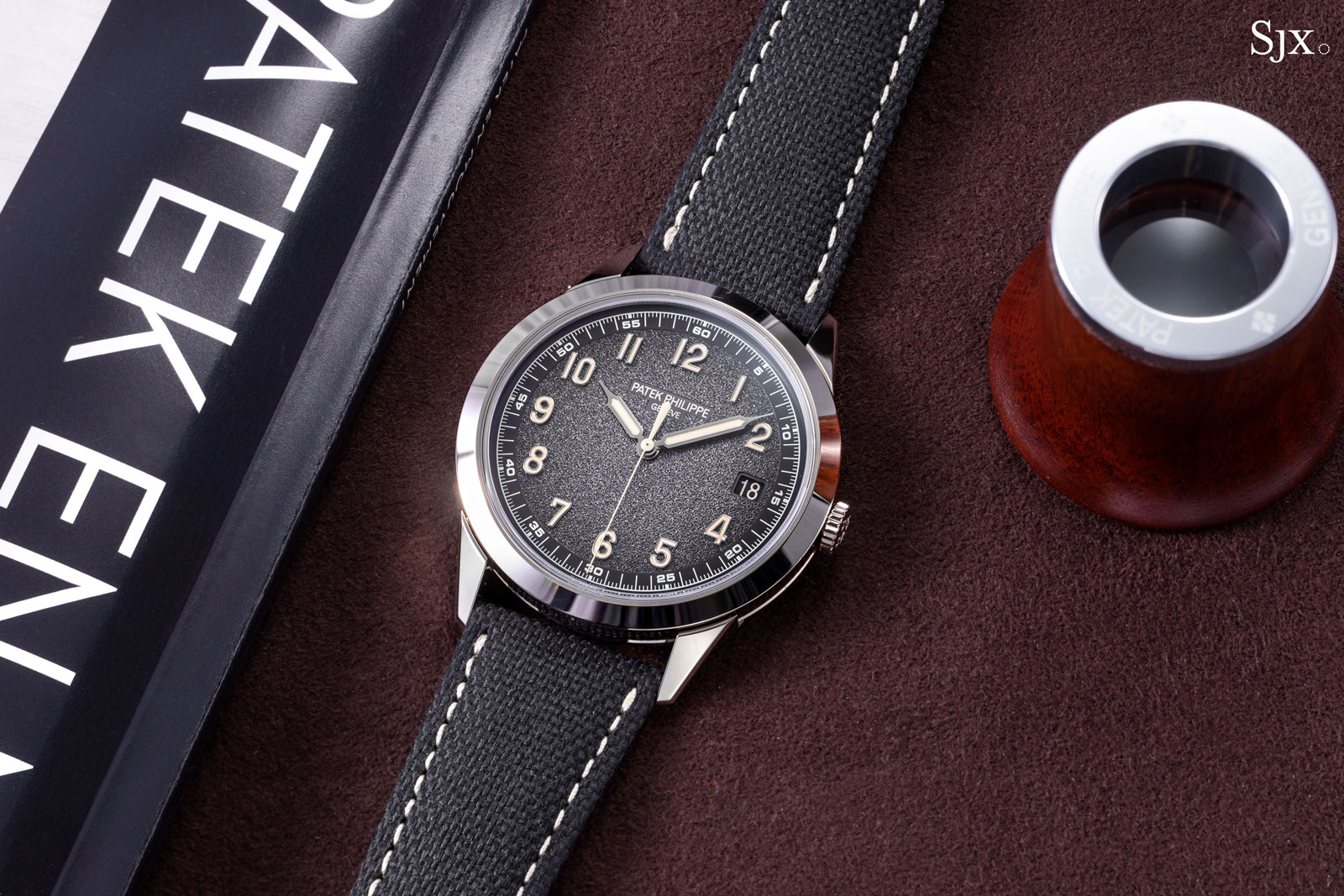
The hobnail decoration means the ref. 5226G has the most elaborate case found on an entry-level Calatrava. The clous de Paris case decoration is unique within the line and historically only found on complicated watches at a far higher price point like the ref. 5531R Minute Repeater World Time.
The hobnail case is obviously more challenging to execute than the typical stamped case of most recent Calatrava models. For one, there’s the challenge of accommodating the pattern despite having lugs. The solution is simple: a two-part case where the lugs are separate from the case middle and instead connect to the case back. This case construction allows for fancier case decoration, explaining why Patek Philippe is turning to it with increasing frequency.
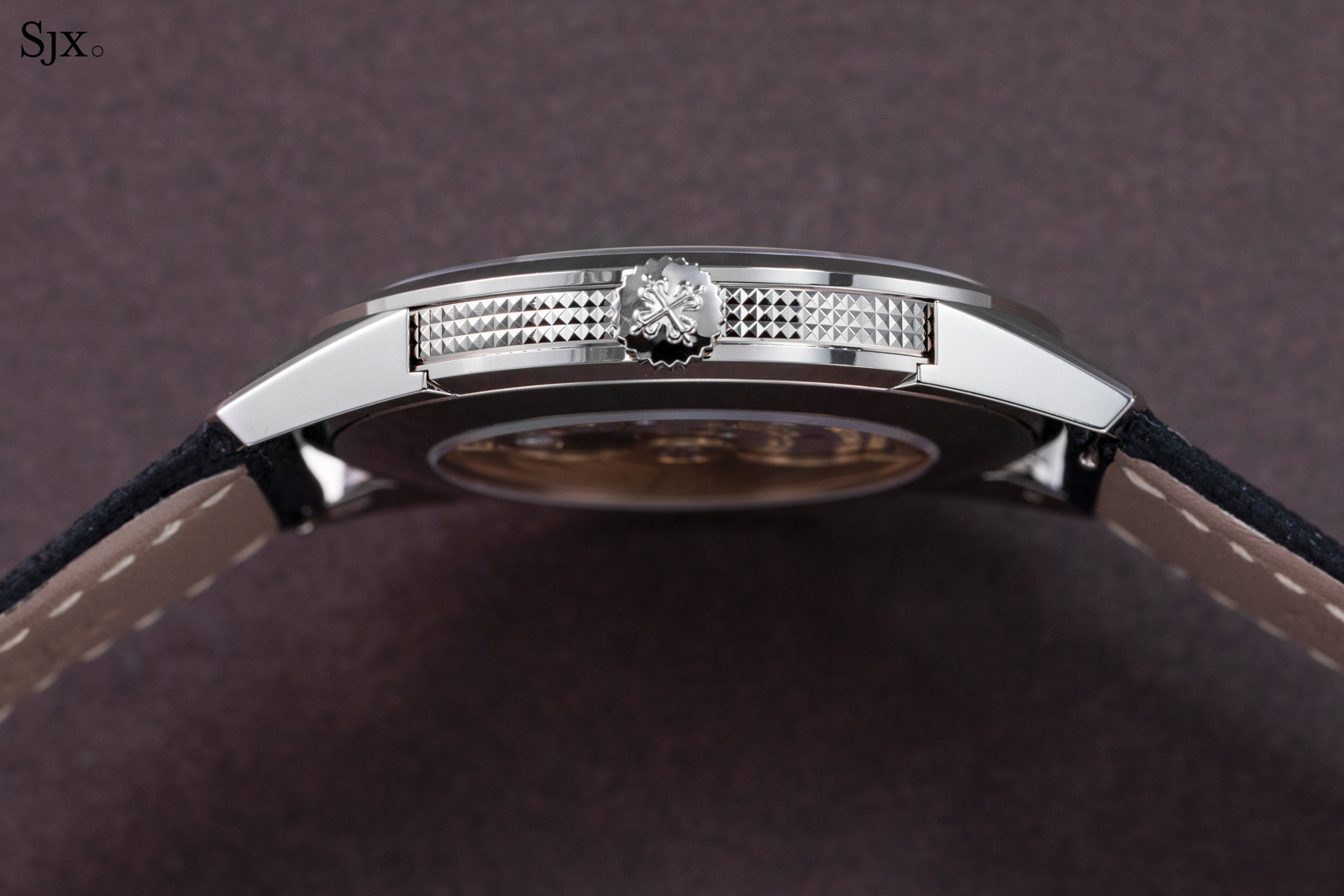
Instead of soldering the lugs to the case middle as is tradition, the lugs are integral with the case back. This means the case middle is actually a ring with an uninterrupted clous de Paris pattern on its flanks.
The smart construction also allows for distinct visual break between the elements, while avoiding the cumbersome process of soldering. That said, this approach creates a visible gap between the lugs and the case that is slightly inelegant (and might accumulate dust), but fortunately the seam is not obvious when the watch is on the wrist.
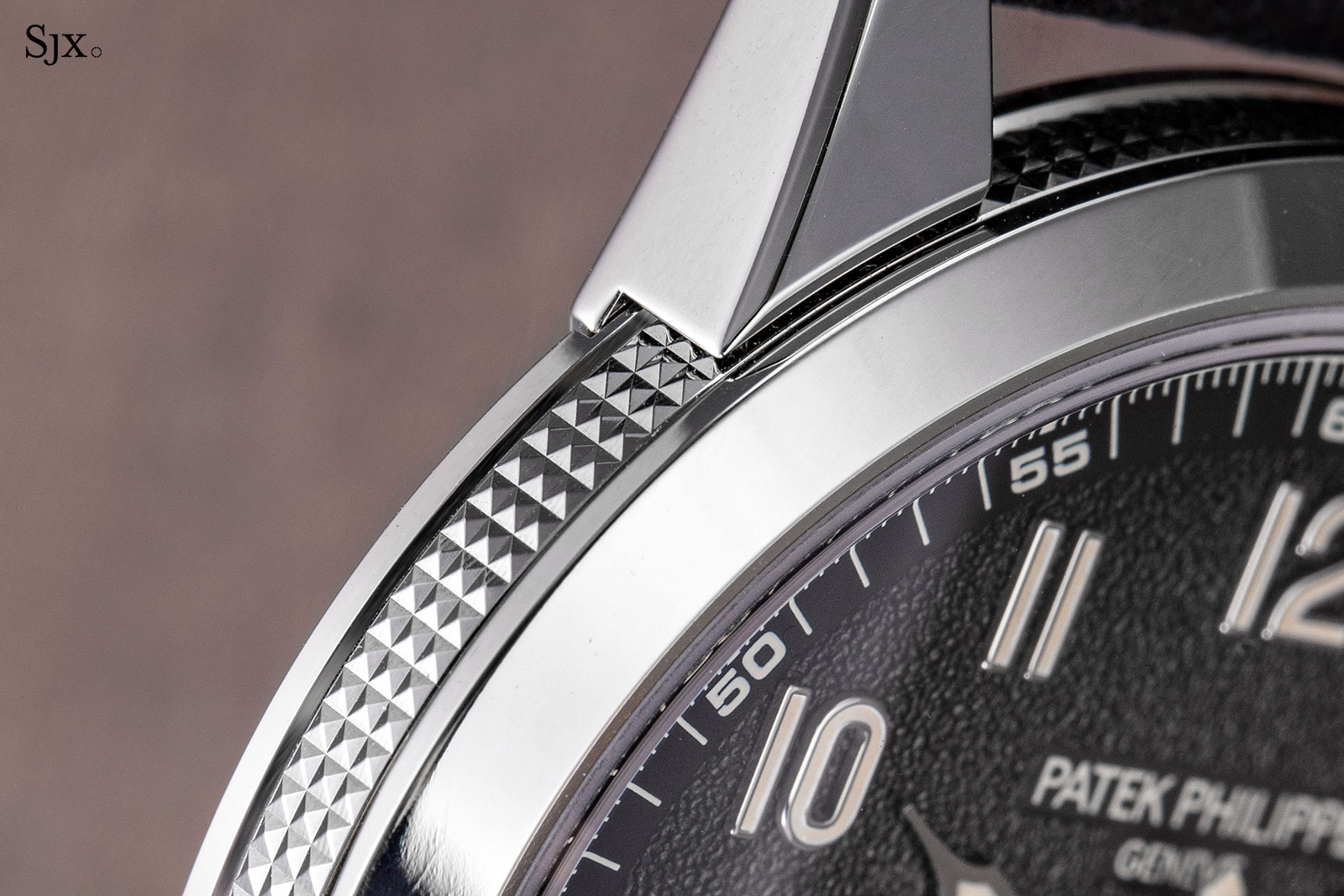
While the case middle is complicated, the bezel and the lugs are simple and rooted in historical designs. I like especially the flat bezel and angular lugs that call to mind vintage models such as the ref. 3448.
Despite the simplicity, the two are distinctive design elements that are strongly associated with Patek Philippe. The style disappeared for about half a century, but made its return with first the ref. 5235 Annual Calendar Regulator and more recently the impressive ref. 5236P In-line Perpetual Calendar.
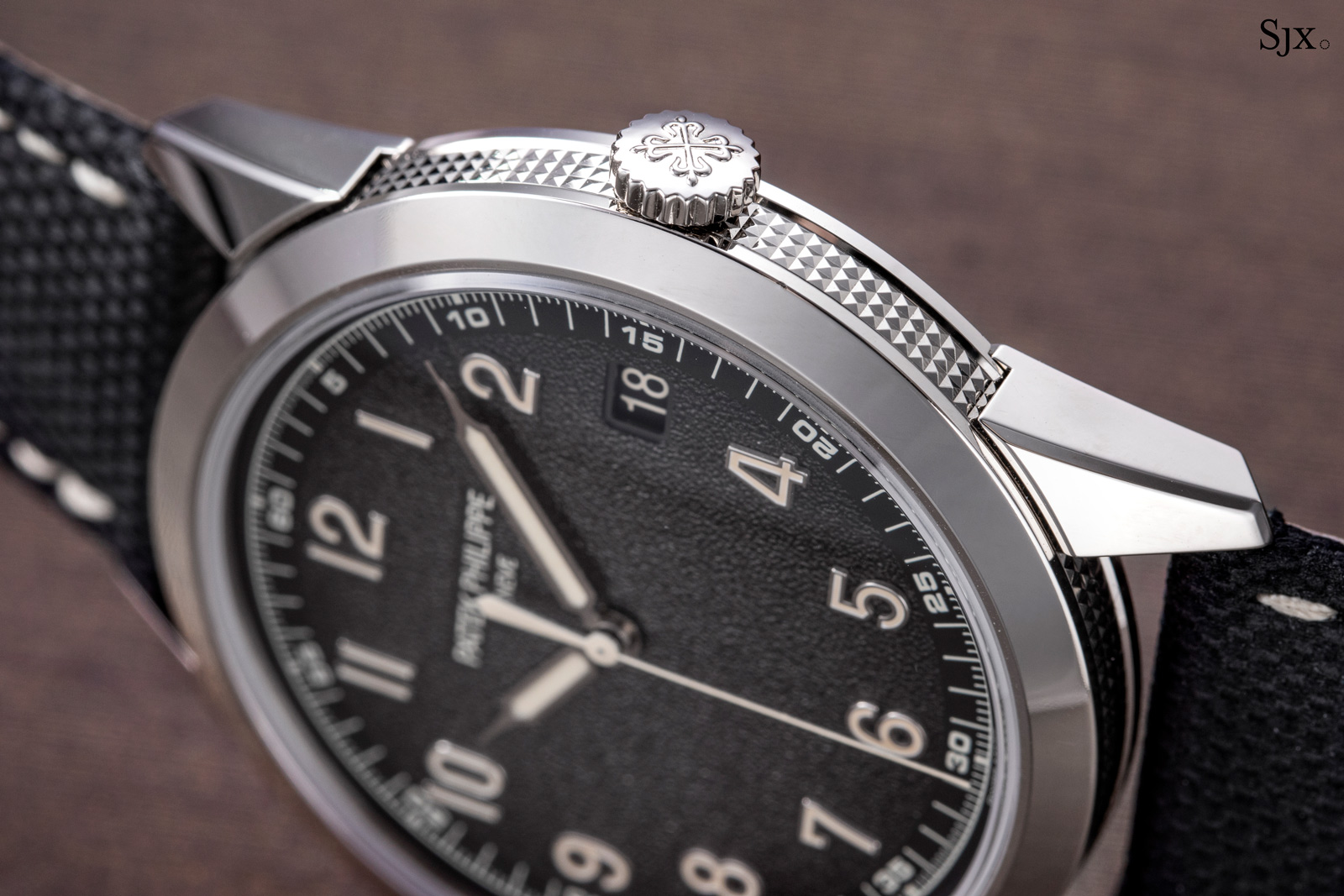
The pointed lugs and smooth bezel give the watch a satisfyingly sharp look that’s perfect for the modern dial. In fact, the coherence between the case and the dial is another reason the I prefer the the ref. 5226G to the ref. 6007A, which had a case with soft, rounded lines.
A final comment on the case is about its size, which is largish for a Calatrava at 40 mm but still compact relative to most modern watches. But in typical Patek Philippe fashion, the ref. 5226G is is relatively thin at just 8.53 mm, thin enough that it might seem too flat. But it looks just right on wrist, neither too big nor too thin.
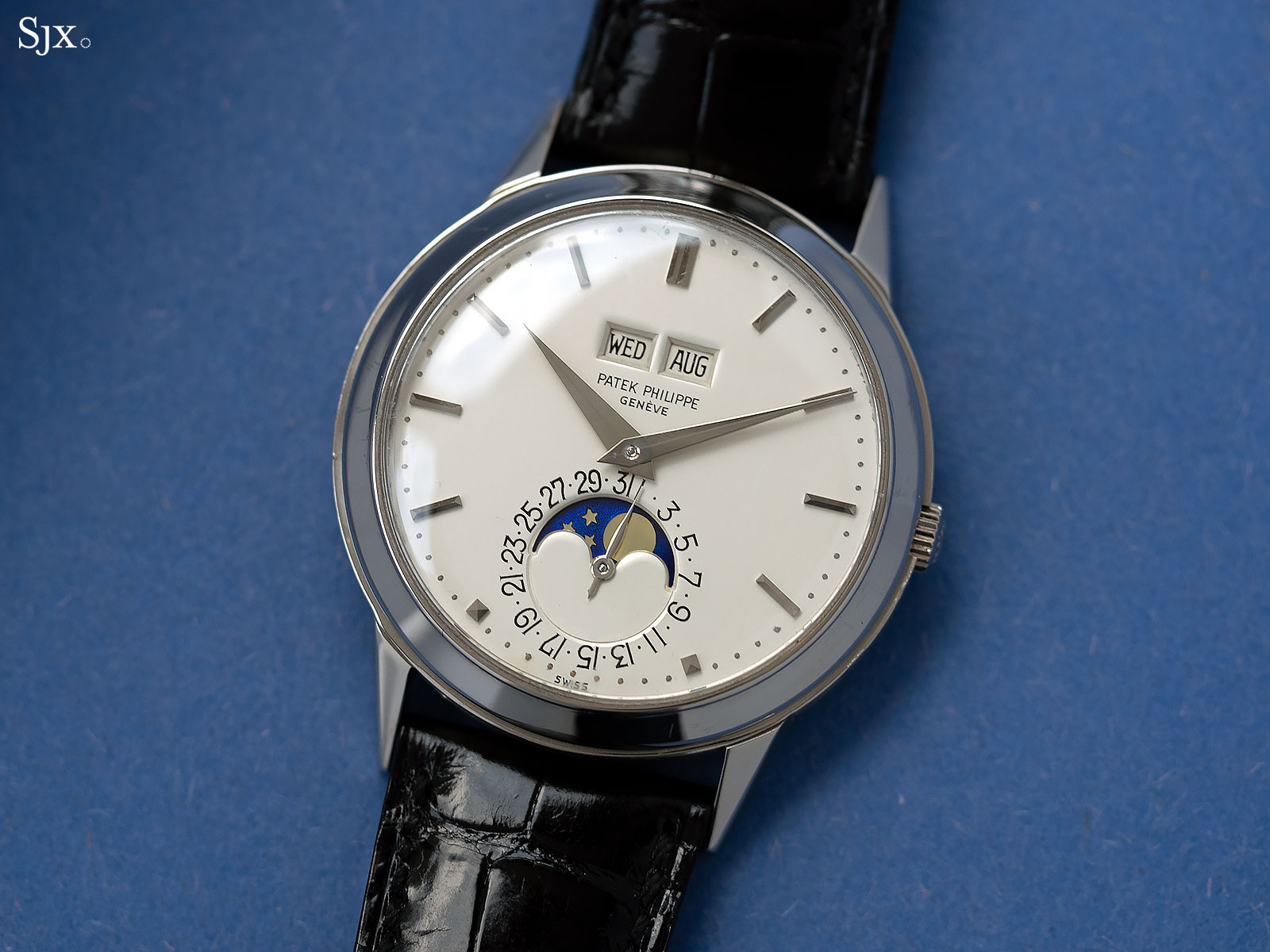
The vintage ref. 3448, the brand’s first-ever automatic perpetual calendar wristwatch
Capturing time
Case aside, the ref. 5226G ie easily distinguished from earlier generations of Calatrava models by its dial. Finished a granular stamped pattern that’s almost organic, the dial is adventurous for a maker that is mostly about traditionally-styled watches.
Camera enthusiasts will see the dial texture as reminiscent of the pebbled leather wrapping on vintage rangefinder cameras and that is the inspiration cited by Patek Philippe in the launch announcement. While the texture might have come from a camera, the dial design is almost certainly modelled on the ref. 565 “Night Watchman”, a 1940s Calatrava that sold for a record sum in 2016.
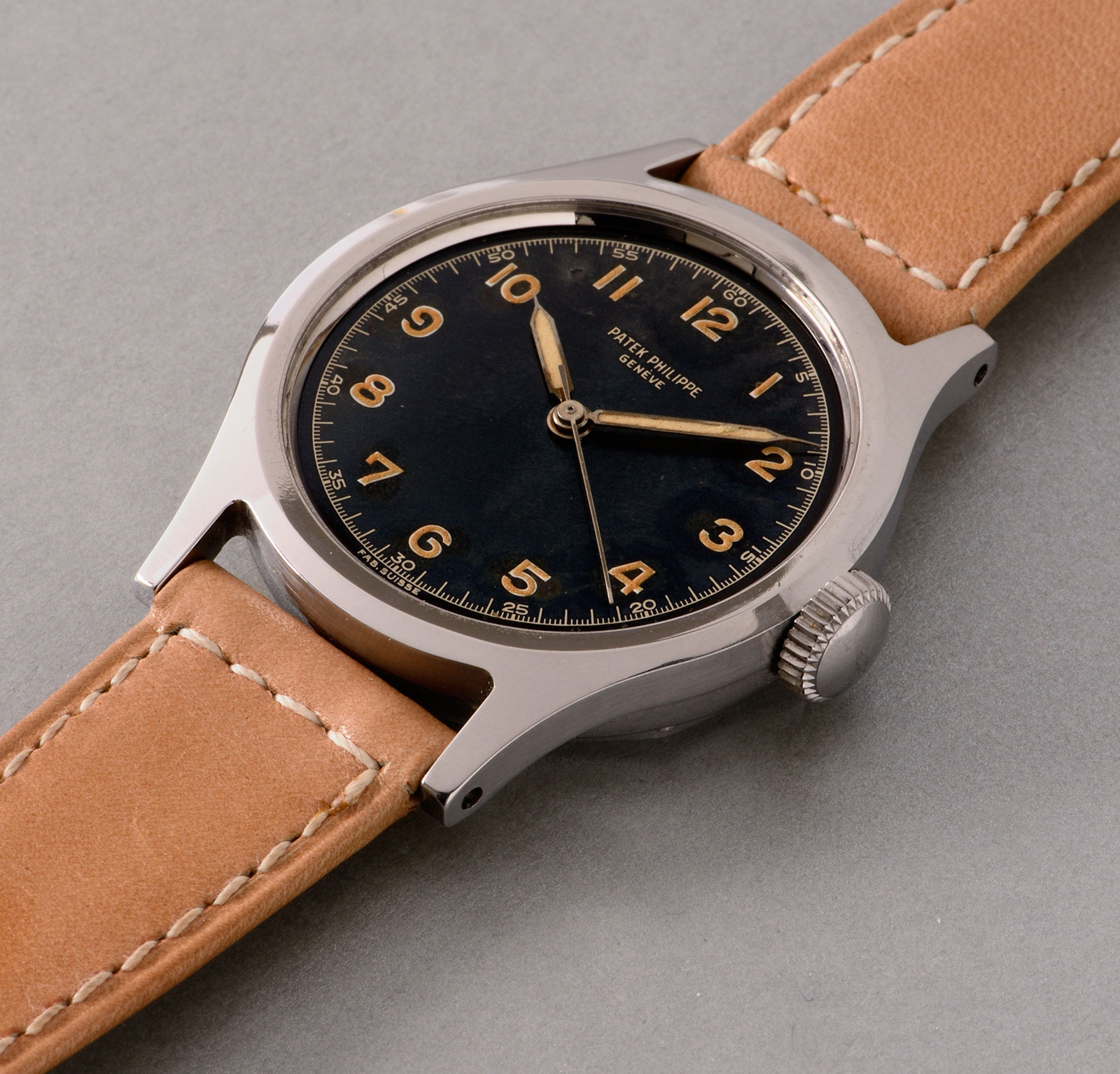
The ref. 565 “Night Watchman”. Image – Phillips
Considering its inspiration of the vintage “Night Watchman”, it’s unsurprising that the dial of the ref. 5226G has a mid-20th century style that is almost a generic “military” look that’s found in watches across the price spectrum.
But it is executed with a high level of quality, making it perhaps the best generic-military-style dial out there. The dial is replete with interesting details. For instance the different fonts and colours complement each other, while it has a depth often lacking in no-nonsense military-style dials thanks to the stamped texture and applied markers.
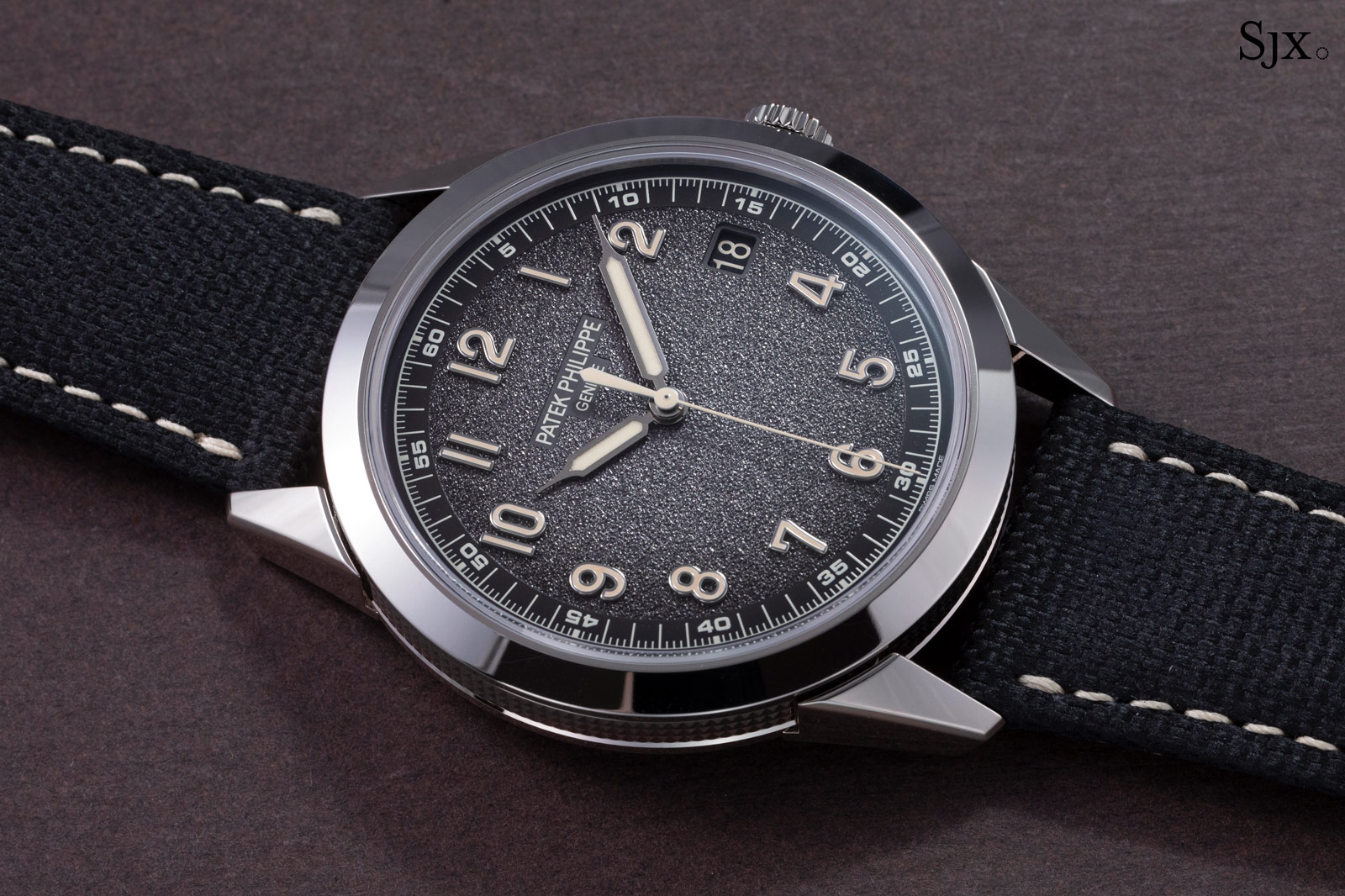
The textured surface has been given a gradient finish that gently darkens towards the edge and culminates in a black minute track. Though a “smoked” finish is common today in practically every price segment, the graduated colour is especially useful on the ref. 5226G. It offsets the granular texture and leaves the dial looking more dynamic.
Admittedly, stamped, patterned dials are common – Grand Seiko for instance has an endless supply of them – but the ref. 5226G does it notably well. The stamped pattern is dense and sharply defined, resulting in more refined finished than on most stamped dials, including those of Grand Seiko. This is as good as it gets with a purely physical production process; higher definition patterning would be possible, but only with additive or chemical processes like electroforming.
The luminescent paint on the hands and indices are a dark beige, which adds a warm tone to the dark dial and is also perfect match for the charcoal tone. Typically I am not a fan of such artificial patina, but here it has been smartly utilised in terms of complementing the dial rather than to create a faux-vintage look.
But beyond the obvious features like the lume and texture, the dial has quite a lot more to offer. The sporty feel of the textured dial is enhanced by details such as the centre seconds as well as the Arabic numerals, which are typically elements associated with military-inspired watches.
Interestingly, the hands and the hour markers are almost identical to those in the ref. 5320 Perpetual Calendar, yet both watches look entirely different. The “syringe” hands and Arabic numerals work far better here, especially in this dark grey finish against the granular dial.
As is usual for a Patek Philippe, the hour markers are solid gold and applied. This distinguishes the ref. 5226G from the typical military-style watch that has flat, printed numerals. Despite being a seemingly simple detail, the applied markers instantly lend the dial a sense of refinement and expense, which is important for a watch like this.
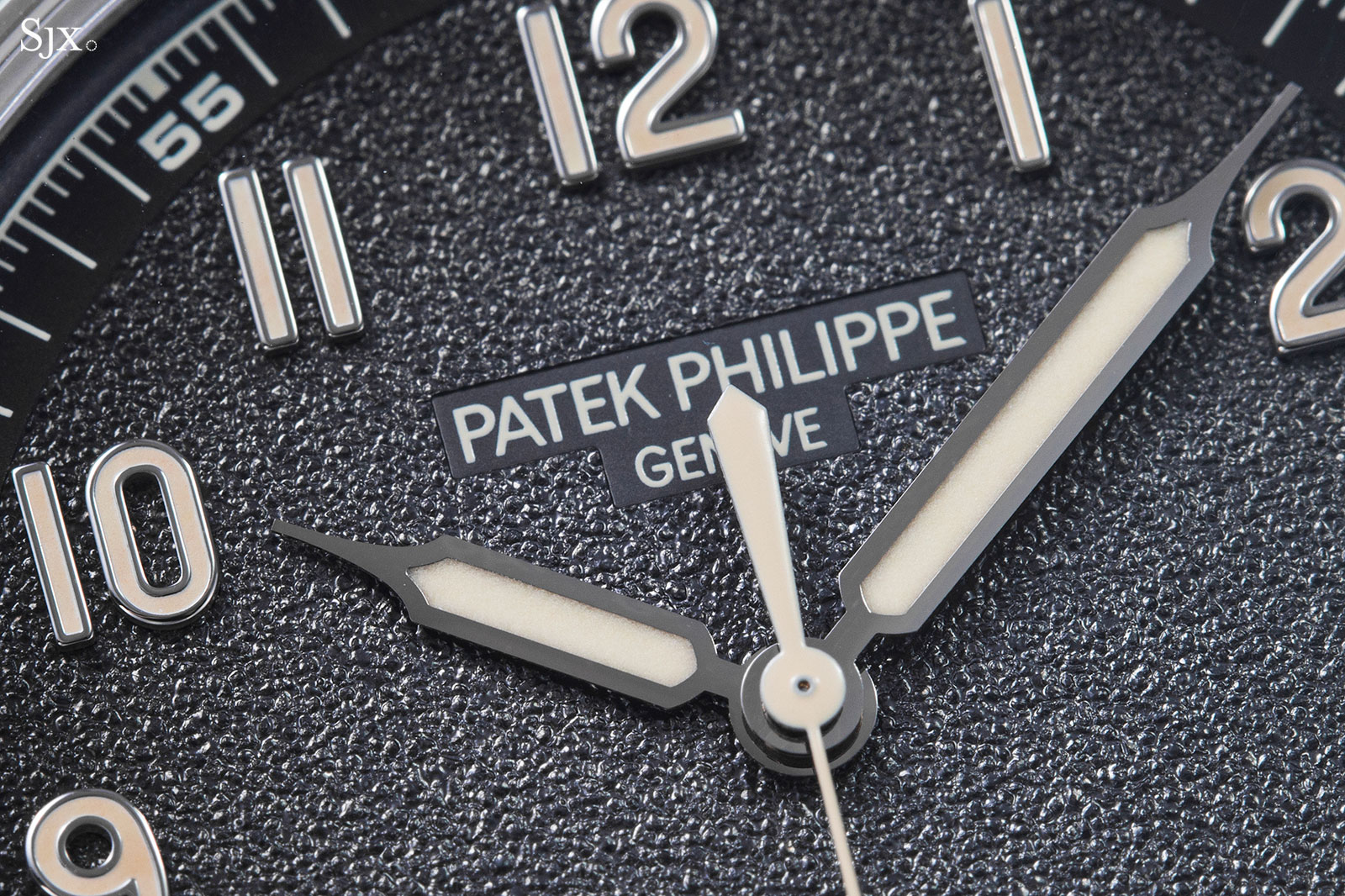
Another detail that I like is the typography. The numerals call to mind the dials on vintage Patek Philippe watches thanks to the font, which includes a “hooked” seven and flat-topped four.
While the applied hour numerals are in a retro font, the five minute markers are decidedly modern. The numbers on the minute track are flat and stubby, adding a touch of instrument-like functionality to the dial.
The twin fonts for the numerals also make sense because the dial is essentially a two-piece affair, with the centre and minute track having different surface finishing and colour, effectively creating a two-tone dial. Notably, the minute track is relatively broad and helps fill up the dial without throwing off its proportions. That’s one reason why the watch looks good despite the case being wider than the movement inside.
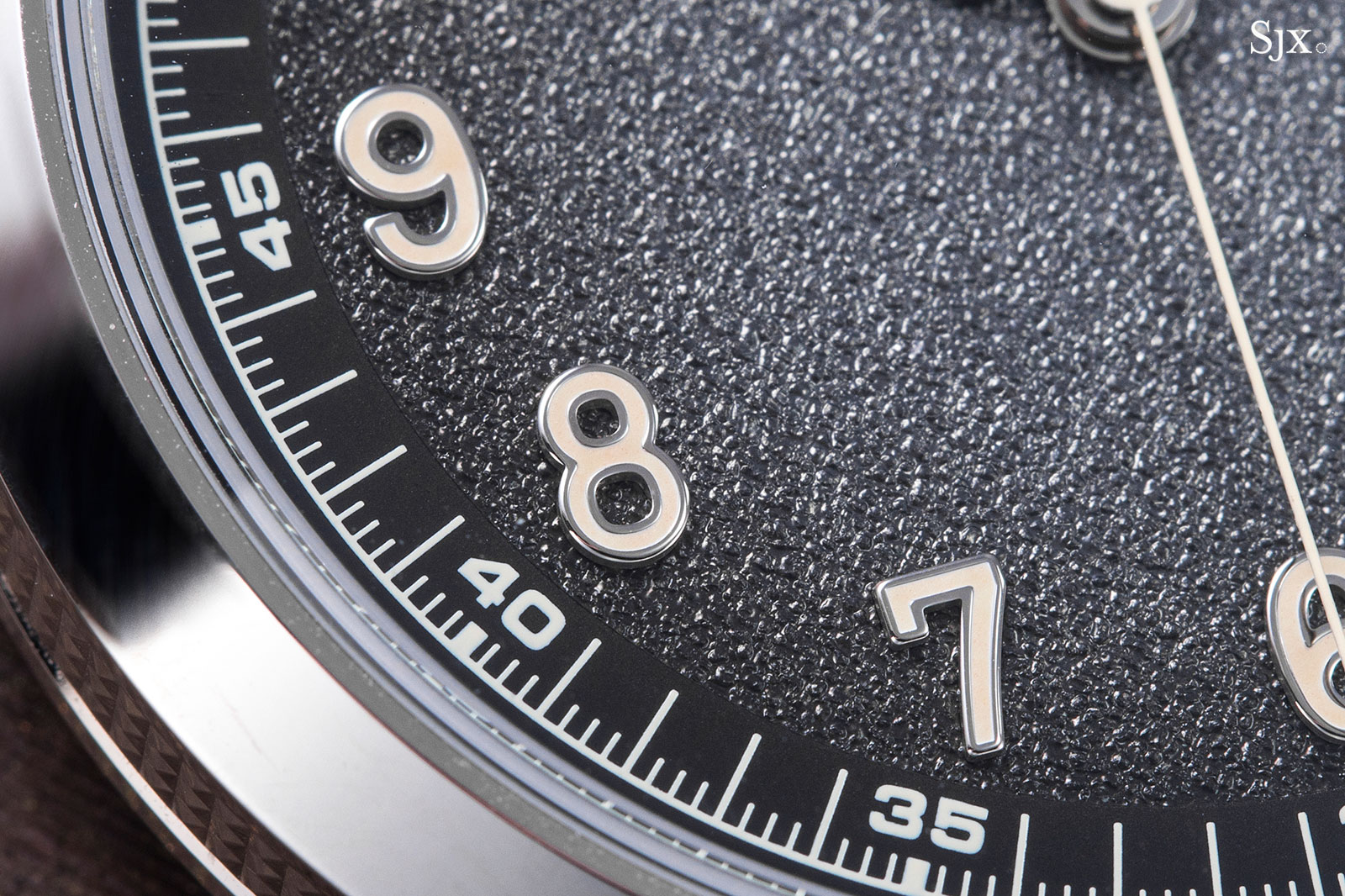
An upgrade automatic
Inside the ref. 5226G is the cal. 26-330 S C, one of Patek Philippe’s latest generation movements. It might look familiar because it’s an upgraded version of the long-running cal. 324, which powered most of the brand’s automatic wristwatches of the last three decades, including complications.
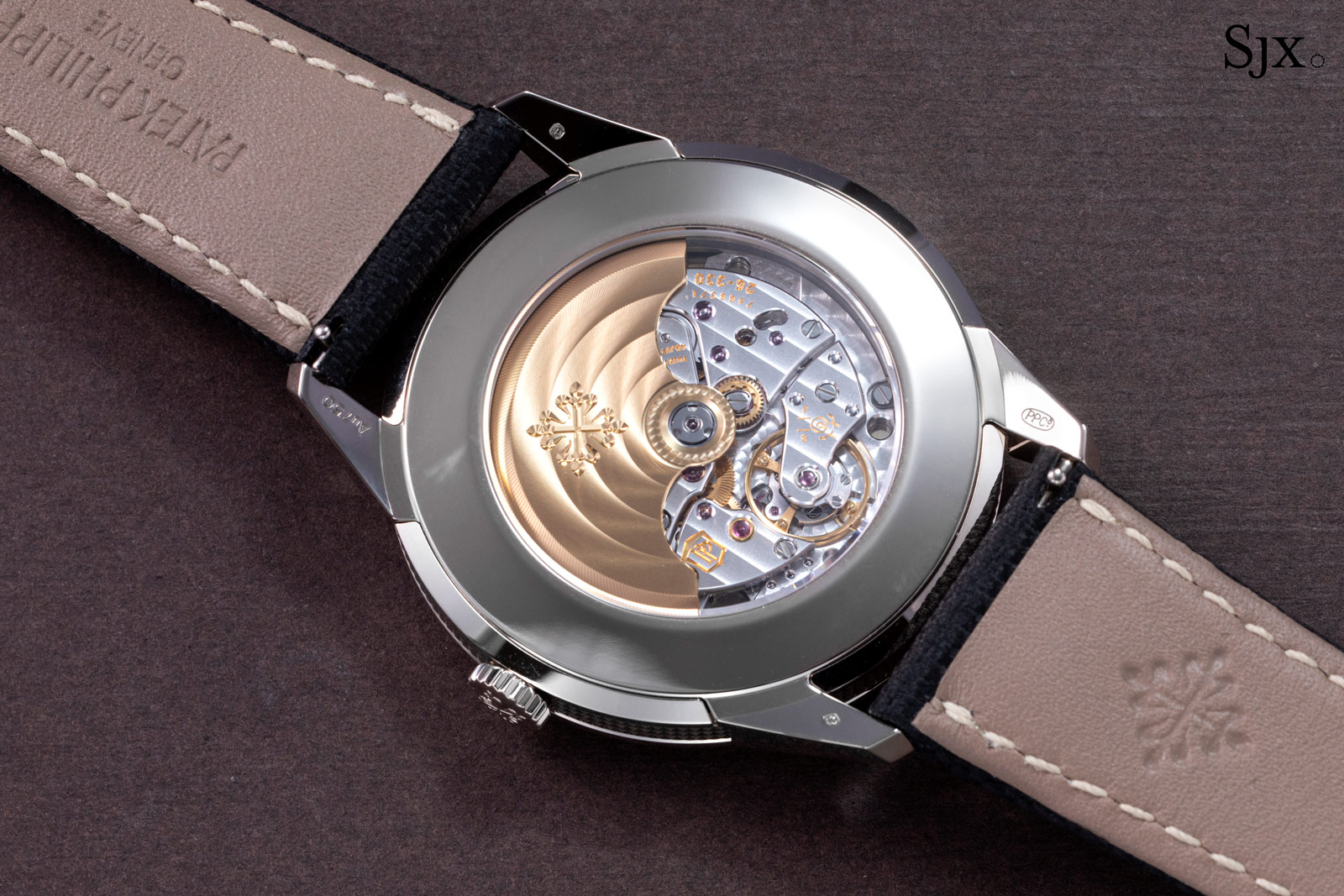
Among the notable upgrades that transformed the cal. 324 into the cal. 26-330 S C is a hack-seconds function that stops the balance when the crown is pulled out, a feature that is surprisingly rare in Patek Philippe watches.
But the cal. 26-330 boasts more important technical upgrades that are invisible. That includes a fourth wheel (that drives the seconds hand) with sprung levers integrated into each of its teeth, which prevents play or backlash, resulting in a smooth motion of the seconds hand. Another is the spring integrated into the winding wheel for the rotor that increase the winding efficiency.
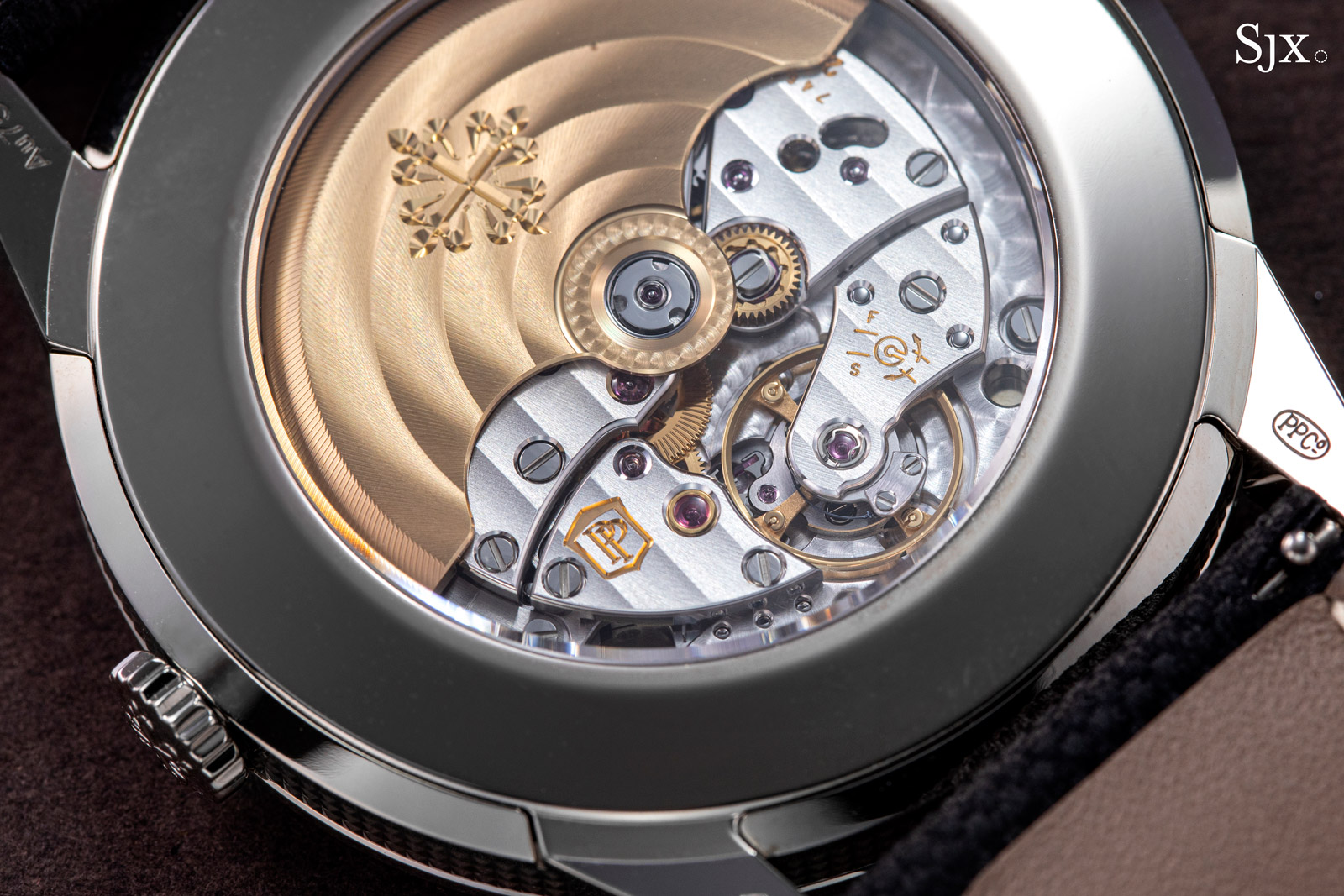
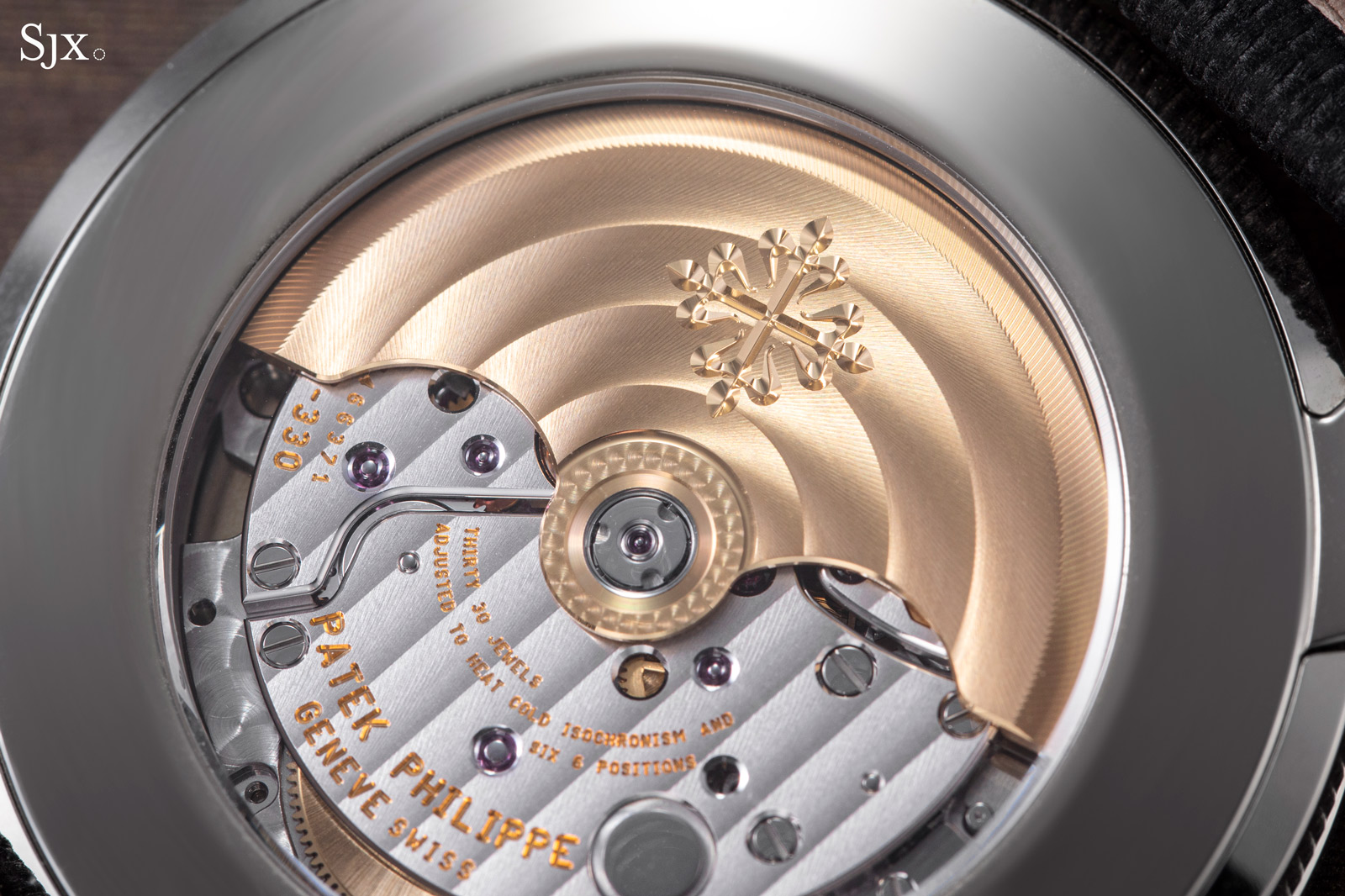
As with most current Patek Philippe movements, the cal. 26-330 S C is also equipped with a Spiromax hairspring, the brand’s in-house hairspring in silicon. Spiromax was debuted in 2006 but has been improved over the years with nips and tucks applied to its geometry and form. A silicon hairspring boasts several advantages over its traditional metal-alloy counterpart, including a superior resistance to magnetism and temperature fluctuations, and silicon also doesn’t suffer material fatigue over time as metal does.
All the technical upgrades do result in improve performance, with the movement guaranteed to run within +3/-2 seconds per day, now the norm for all of the brand’s movements that bear the Patek Philippe Seal. It’s a tight range that’s amongst the most stringent amongst high-end brands and one surpassed only by the standards at industrial giants such as Rolex.
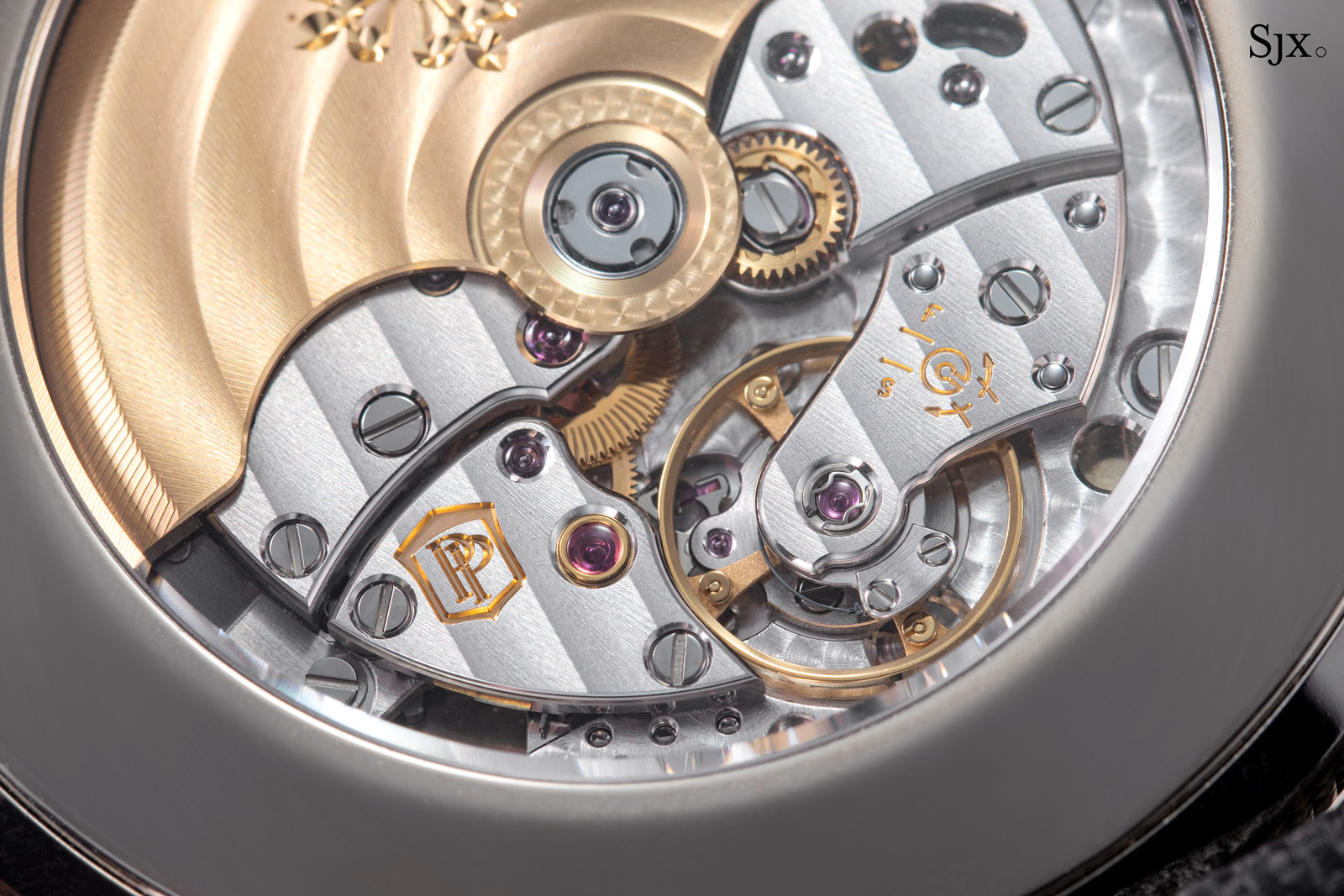
In terms of finish, the cal. 26-330 looks much like a cal. 324 from a decade ago at arm’s length. It’s appealing thanks to the gold rotor and striping on the bridges, but up close one might expect a cleanly industrial finish.
But under magnification it is clear that the finishing has been improved compared to comparable watches from the recent past. That might be due to the enhanced capabilities of Patek Philippe’s manufacture or merely reflective of the gradual improvements that Patek Philippe has implemented in its timepieces.
The bevelling for the bridges, for instance, is not only polished but more pronounced and definitely rounded, as opposed to bearing the milling marks that are typical of a conventional industrial finish. Also, the various corners of the bridges are sharper, with the bevels meeting in a careful point.
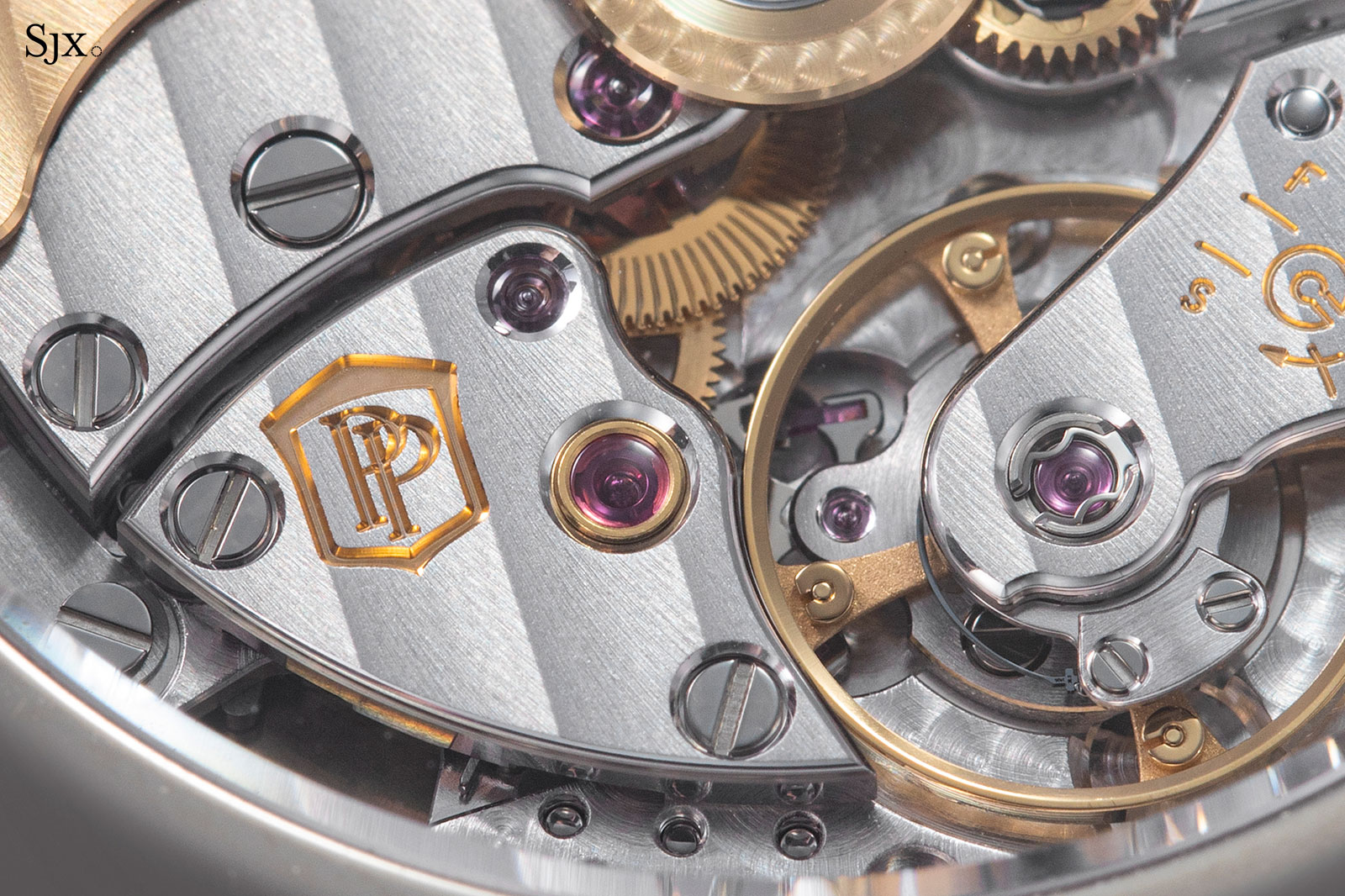
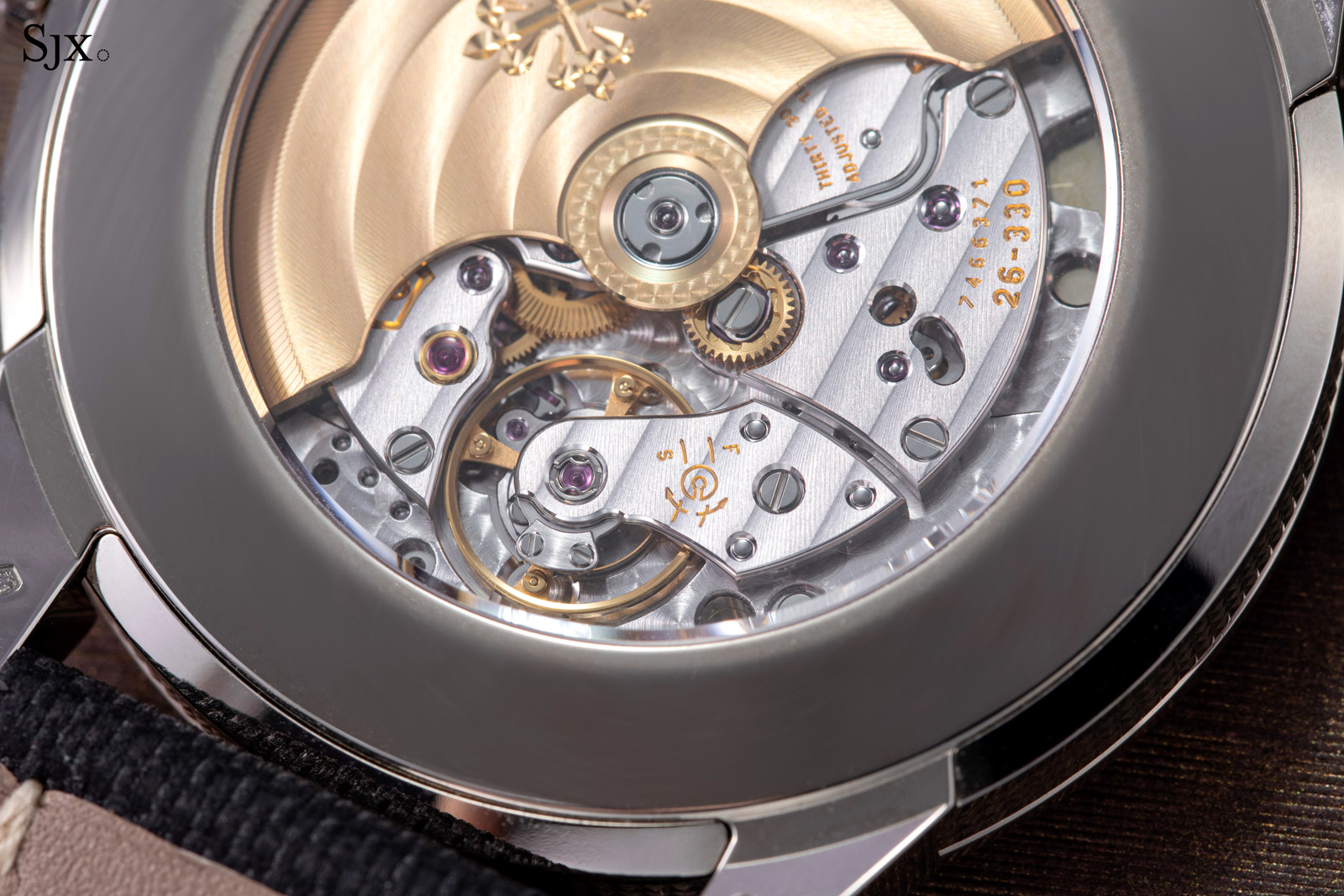
Conclusion
As yet another Calatrava in white gold with three hands and a date – one equipped with a movement that looks like the cal. 324 at that – the ref. 5226G might not seem special on paper. Even the vaguely military style isn’t unique. But the ref. 5226G is surprisingly compelling in both design and execution.
The watch was clearly conceived with significant attention paid to its detail, which have been refined such that almost everything is just right. With the impressively finished dial and case, it was clearly born from brand’s knowhow in design and manufacturing that was accumulated as Patek Philippe vertically integrated over the last two decades. While no doubt an expensive watch, the ref. 5226G lives up to the price, probably more so than most of its predecessors.
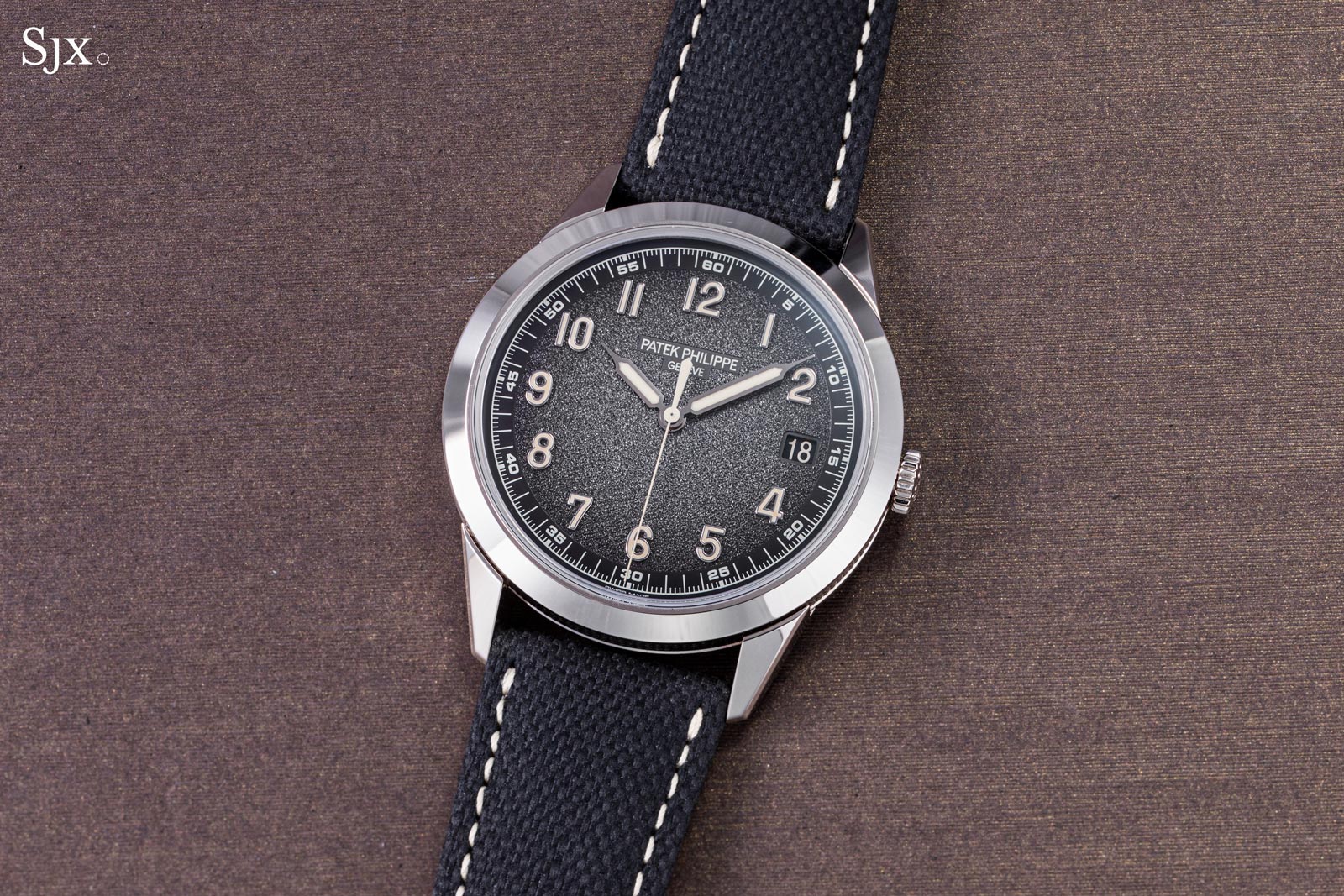
Key facts and price
Patek Philippe Calatrava
Ref. 5226G-001
Diameter: 40 mm
Height: 8.53 mm
Material: 18k white gold
Crystal: Sapphire
Water resistance: 30 m
Movement: 26-330 S C
Functions: Hour, minute, second, and date
Winding: Automatic
Frequency: 28,800 vibrations per hour (4 Hz)
Power reserve: 35-45 hours
Strap: Black calfskin with embossed pattern, additional strap in beige calfskin with nubuck finish
Limited edition: No
Availability: Now At Patek Philippe boutiques and retailers
Price: US$39,030; or 51,500 Singapore dollars
For more, visit patek.com.
Back to top.

